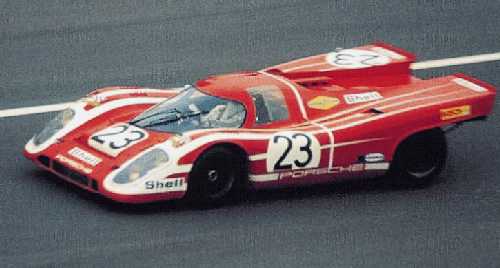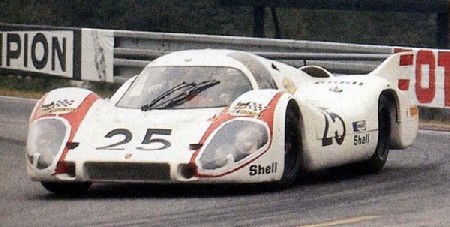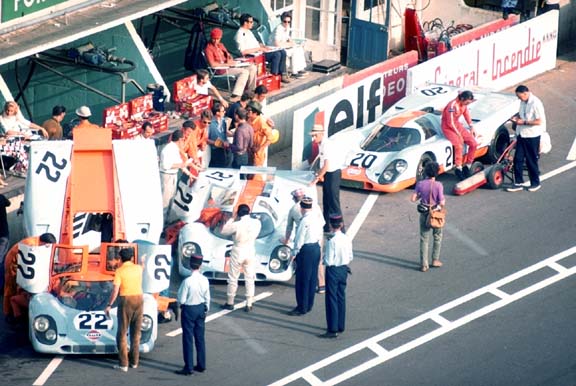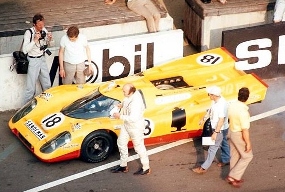
|
|







The Porsches |
By Simon Taylor and Patrick McNally (Autosport 18 June 1970) John Wyer's Gulf-sponsored JW Automotive team, winners of the last two Le Mans races for Ford, brought three 917s wearing the customary bob-tailed coupé bodework. Following his usual policy of only racing fully tested equipment. Wyer decided not to opt for the streamlined long-tailed bodywork that Porsche had themselves developed for this race: two cars had been written off in private testing in Germany, and had proved to be unstable on long fast corners and prone to aquaplaning in the wet, although in a straight line and on slower corners they worked quite well, instead JW took their existing cars to the MIRA wind tunnel, as result of which they added a small wing in the central trough of the rear bodywork which increased the downforce and required less spoiler depth, with consequent aerodynamic advantage. |
The cars of Jo Siffert/Brian Redman and Pedro Rodriguez/Leo "Leksa" Kinnunen, 917/004 and 917/016, both ahd 5-litre engines, while the third car, making the return to the JW fold for David Hobbs/Mike Hailwood had less powerful but more proven 4.5-litre. This one was brand new, 917/026. A comparison between the JW cars and the Salzburg entries immediately showed the sort of detailed work that goes into a Wyer 24-hour car. During the season the JW cars have adapted separate oil pipes, as the existing arrangement whereby the chassis tubes carried the oil had made the cockpit too hot for the drivers; also in the interests of reducing driver fatigue, cold air ducts to the cockpit had been added. Two batteries, two alternators and a larger starter motor specially developed by Borsch gave added electrical reliability, and quickchange headlamp units had been fitted; the front wings were strengthened with a small alloy framework and alloy sheet stoneguards after bodywork weaknesses had shown at Daytona. The catch to prevent inadvertent selection of first gear had been modified so that first could in fact be used easily if necessary. The very hard springs made of tapered titanium strip that were adopted for Daytona to cope with the G-forces on the banking had proved ideal for other circuits too, and more understeer had been built in by increasing the diameter of the front anti-roll bar and reducing diameter of the rear one. After Kinnunen's gearbox failure at Spa Porsche made some special input shafts which had a smaller diameter oilway and were machined from better material. They also made up new first and second gears which were not drilled for lubrication at all to increase their strength; these were only used on the torquier 5-litre cars, as after Spa cracks radiusing from the oilway had been found on the 5-litre gearboxes. A season change from ATE to Girling brakes was that, as the standard Girling brakes would not fit the mountings on the rear upright, POrsche themselves made special alloy stirrup pieces to adapt the Girling caliper to the existing upright. They took the opportunity to make stirrups in different sizes so that for this particular race they could use thicker brake pads. The Wyer drivers were set an 8400 rpm rev-limit for this race, 500 rpm lower than usual. The gearbox and brake modifications were also in evidence on the three 917s from Porsche Konstrucktionen KG of Salzburg, but unlike JW this team decided to bring one of the long-tailed streamliners (917/042). This new machine, plus their blue and white short-tailed car (917/020), had 5-litre engines, while the third (917/023), which was orange, had a 4.5-litre. The top Salzburg pair, Vic Elford/Kurt Ahrens, had the choice of the two 5-litre cars, for both had tried the long-tailed machine at Hockenheim and at Wolfsburg but wanted to defer their decision until they had seen how it handled on the Mulsanne Straight. One result of the German tests had been the adoption of a horizontal wing above the tail fitted between the two vertical fins. |
In the orange car were Richard Attwood/Hans Herrmann, and in order to qualify the short-tailed 5-litre as an official entry Porsche´s Sporting Director Rico Steinemann, who retired from racing at the end of 1968 to take up his job with Porsche, put down as nominated drivers himself and his old Swiss teammate Dieter Spoerry (who was at Le Mans anyway to drive one of the Martini 908 Spyders). Rico had to telephone his wife to find out if all his old racing overalls had been given away; she managed to find a pair, although Rico's found them rather a tight fit now! Porsche's computer said that the long-tailed car should be geared for 236 mph, but as it turned out the computer had failed to take into account the amount of power absorbed by the tyres at this sort of speed. |
A second long-tailed car, 917/043, gaily painted in a psychedelic conbination of green and blue, was entered by Hans-Dieter Dechent's Martini-sponsored team for Gérard Larrousse/Willi Kauhsen. All the 917s were only using four of their five speeds, incidentally, except for these two long-tailed machines. The eight 917 was 021, that of Finn Aarnio Wihuri, the yellow and red car that Gijs van Lennep and the late Hans Laine had already driven at Monza and Spa. Wihuri took over David Piper's entry, and Piper himself co-driving with van Lennep. Looking after their own interests, or rather hedging their bets, Porsche had prepared both of these cars themselves. |
The John Wyer Gulf Porsche 917s |
The long-tailed Porsche 917 LH driven by Vic Elford/Kurt Ahrens |
The Porsche 917K driven by Richard Attwood/Hans Herrmann |
The second long-tailed Porsche 917 LH driven by Gérard Larrousse/Willi Kauhsen |
The Porshce 917K driven by David Piper/Gijs van Lennep |